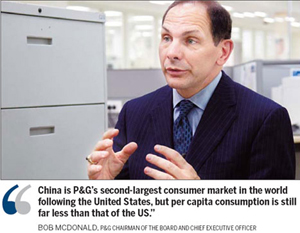Investment
P&G promises 'full court press' in China
By Bao Chang (China Daily)
Updated: 2010-08-19 14:57
 |
Large Medium Small |
BEIJING - The world's largest consumer goods company Procter & Gamble Co (P&G) said that it plans to invest at  least $1 billion in China over the next five years, in an effort to strengthen both its manufacturing and research and development capabilities.
least $1 billion in China over the next five years, in an effort to strengthen both its manufacturing and research and development capabilities.
Bob McDonald, chairman of the board and chief executive officer of P&G told China Daily on Wednesday that "China is P&G's second-largest consumer market in the world following the United States, but per capita consumption is still far less than that of the US."
For that reason, P&G is compelled to "continue to increase investment in the market", he said.
According to McDonald, P&G generated $5 billion in sales in China for fiscal year 2009, accounting for 7 percent of its global sales revenues of $75 billion.
|
 |
As part of the investment plan, P&G will set up an innovation center in Beijing with an investment of $80 million and over 500 employees from 16 countries.
The innovation center aims to develop new products that are tailored especially for emerging markets including China.
"One of the reasons we (decided) to establish the innovation center here is we can take advantage of China's universities, research and development technologies and scientists," said McDonald.
The innovation center will mainly be involved in the development of products including fabric care, oral hygiene, baby care and snack foods.
In addition to the innovation center, a distribution center will be built next month in Guangzhou where the firm's Chinese headquarters is located, serving distribution for both home and abroad.
McDonald also said that P&G has decided to build the tenth new factory in the Yangtze River Delta region.
During the past over two decades, P&G has invested more than $1.5 billion in China.
The company's aggressive investments are driven by its ambitious goal of adding one billion more new consumers worldwide by 2015, from the current four billion.
Last year, sales in emerging markets contributed 30 percent of the company's total sales of $75 billion around the world.
McDonald is expecting emerging markets will contribute more than half of the company's growth next year.
"In the Chinese market, we're also planning to introduce more product categories to appeal to every consumer here," McDonald said, noting that P&G is currently in around 15 products categories in China, versus 35 in the US.
According to McDonald, one of the biggest challenges for P&G's development is governmental protectionism during the financial crisis.
P&G is now working with the Chinese government on a project named "10,000 Villages" designed to create distribution networks for household products in rural areas in China to reach more Chinese consumers as it targets 5 billion consumers by 2015.
China Daily